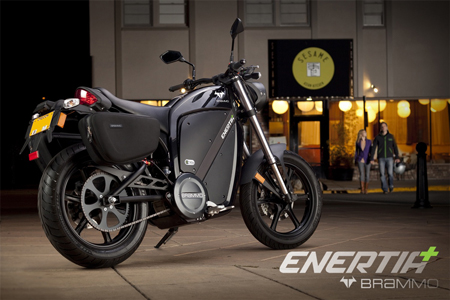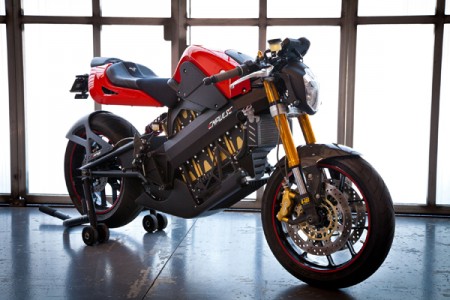One of the more notable electric motorcycle companies to be producing consumer focused models these days is Brammo. The electric motorcycle manufacturer, based in Ashland, Oregon, has been around for a number of years and focuses its development efforts on electric vehicles it believes capture the essence of traditional motorcycles, but don’t have the carbon emissions of their gas fueled cousins.
Brammo for 2011 recently unveiled the Enertia Plus, which will price for around $9,000. It sports an electric motor with peak motor power of 13kW @ 4500 rpm and a maximum torque of 40 N-m, 29.5 ft-lb @ 0 – 1450 rpm. On the higher end, the company also has its Empluse model, said to hit speeds over 100 miles per hour for sustained periods. To learn more about Brammo and its interesting electric motorbikes, we turned to Adrian Stewart, Brammo’s director of sales and marketing, for some answers:

EarthTechling (ET): What is the back story on Brammo? How did it come to be founded?
Adrian Stewart: In early 2005, Brammo purchased the license to produce the Ariel Atom, an exo-skeletal vehicle designed by Nik Smar. Brammo’s license allowed the company to produce the vehicle for the North American market only. After we secured the license from Ariel CEO Simon Saunders, Brammo reverse-engineered the vehicle, making several improvements along the way, and began production. The company could not secure the Honda engines which were installed in the UK versions of the car, so we approached GM and were able to obtain the supercharged GM Ecotec engine, although a limited run of ten Atoms came equipped with Honda K20A engines. The company sold just over 130 Atoms during a 20 month period. Jay Leno bought one of them and wrote an extensive review of it for Popular Mechanics.
In 2007, Bramscher decided that his next super car project the Rogue GT with nearly 1,000 hp (750 kW) and 3 mpg-US (78 L/100 km; 3.6 mpg-imp) was not a viable product in a post Inconvenient Truth world. Brammo began looking at electric motors as a possible next step. Brammo began developing an electric Ariel Atom and learned some of the intricacies of electric drivetrains while it worked toward production of the vehicle. Although Ariel Atom UK had been amenable to Brammo’s re-engineering of the Atom for a GM motor due to the unavailability of the Honda system used in the UK, it became economically unfeasible for the electric Atom project to continue due to the amount of the royalties required by Ariel for the electric vehicle. Brammo then decided to develop its own electric vehicle (EV) from the ground up.
ET: Why get into electric motorcycles?
Stewart: Brammo’s experience with building supercars, coupled with its research of electric drivetrains and then-current battery technology led to the belief that with the power to weight and energy density ratio of lithium batteries, an EV was possible, but that the vehicle’s weight was a crucial concern. The decision was made to produce a lighter motorcycle. Brammo focused on designing and building the Enertia prototype. After completing the prototype, the company met with investors and determined that Brammo Motorsports needed to become Brammo, Inc., and that it would thereafter focus fully on electric vehicles.
ET: What kind of riders, do you think, enjoy electric motorcycles over gas powered ones?
Stewart: All motorcycle riders enjoy riding electric motorcycles. The question really is – which ones actually go on to own an electric motorcycle? I think it’s way too early to draw conclusions – the products are evolving at a rapid pace and the level of knowledge and experience among riders and traditional motorcycle dealers is for the most part very low at this point in time. On top of that there are significant variations between the USA and Europe and between those markets and Asia. In addition to the consumer market there is the fleet market – which is currently the largest market for electric vehicles, including those with two wheels. Here your question is easier to answer, as fleet users buy electric over gas because of their zero emissions, low running costs and predictable routes.
ET: What makes Brammo motorcycles, in your opinion, better than other electric motorcycles on the market?
Stewart: What differentiates Brammo from all the other nascent brands is that our motorcycles are designed for mass production. It’s relatively easy to design and build a single electric motorcycle and if you have enough money you can even make it look pretty good too. Some companies can even hand build bikes in batches that work and look good but they are too expensive for what they deliver. We design bikes that can be commercialized and put into continuous production. Part of this design also involves reliability and serviceability.

Brammo recently announced our strategic partnership with Flextronics. This relationship will enable Brammo to establish a manufacturing capability in each of our major markets very quickly, while maintaining our reputation for producing electric motorcycles of the highest quality – this is only possible because we designed the bikes this way when we started. This strategy is only possible if every single aspect of the bike has been designed and thoroughly documented. With Brammo you can have it all; styling, performance and affordable.
ET: What future product plans can you share with us?
Stewart: We use our racing program to develop and prove new ideas – so what we race on the track will very often find its way into the show room. The 2011 Brammo Empulse is the first family of water cooled electric motorcycles and they evolved from our 2009 TTR race bike. If you take a close look at our 2011 race bikes you might just see what will be available from Brammo in the future.